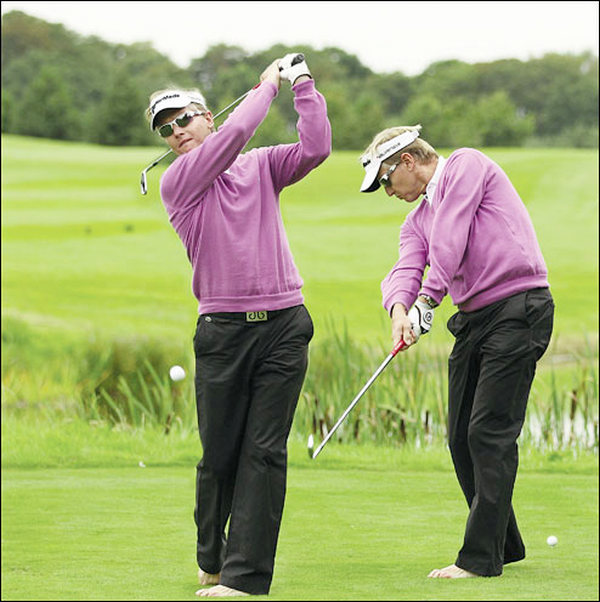Technically speaking, walking is almost impossible to teach, like a golf swing. And yet it could be as simple as placing one foot in front of the other… and playing to your natural rhythm. Stéphane Bachoz introduces principles of the Triangulaid coaching system – which he describes as being ‘as efficient as it is unconventional’ – in a bid to help you experience the sensations, balance and coordination of a natural motion
Time to leave behind those pre-conceptions about the golf swing, the technical thoughts that have failed to improve your game, and to open your mind to a more natural way of playing the game you love. A good golf technique can – and should – be as natural as walking, as 2003 French Open champion Philip Golding illustrates here. A flowing, swinging motion can be yours if you learn to trust in your natural movement.
Originally pioneered by Welsh professional Bill Owens in 1991, the concepts of ‘Triangulaid’ provide a logical solution for everyday club golfers who would love nothing more than the pleasure of playing natural golf. Many of the problems that we see in the game today stem from the fact that people are obsessed with playing ‘swing’ rather than actually playing the game. Wrapped up in the mechanics of what they think they should be doing, they forget that the goal is to make a golf swing – not a ‘hit’ – to propel the ball towards the hole.
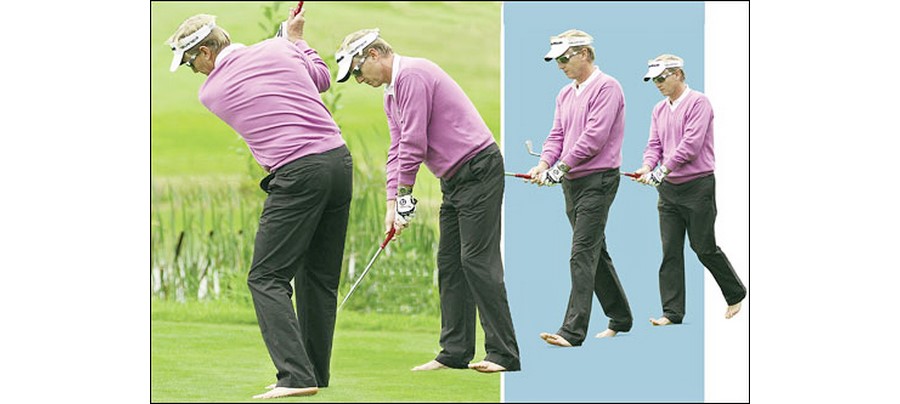
With the club in front of you, lead in with the right foot as you place it behind the ball.
Natural walking pace establishes the rhythm of your motion as you take three steps towards the ball.

Weight shifts naturally, right side to left side as you swing– just as it does when you walk
To find such pleasure, Triangulaid places the emphasis on doing what comes naturally and encouraging individual character to shine through. Improvements in club technology have helped to make this possible; just as skiing instructors coach differently today, thanks to parabolic skis that make the sport easier for all levels, so coaching in golf should reflect the fact that modern equipment tolerates a swing that is less than perfect. We have the tools to enjoy good ball striking with a swing based on natural motion.
My belief is that the vast majority of golfers out there can improve their game immediately if they let go of cliches and pre-conceptions and learn to embrace the natural motion that lies within. This is a state of mind as much as anything else. So, the first step here is to do away with old habits and prepare to explore new sensations as you find your natural golf swing.
As Jack Nicklaus always said, good golf starts from the ground up. To find your natural movement, you have to engage with the sensations in your feet – the interaction you have with the ground. The true rhythm of your swing matches exactly your natural walking rhythm. The kinetic chain comes from the feet – you have to use the energy you absorb from the ground to inspire a natural sequence of movement in the body. Feel it through your toes. The arms are like heavy ropes, relaxed as they hang from your shoulders – they respond to movement from the feet, not the reverse.
Do you consciously think about controlling your arms as you walk? No, of course not, because they are allowed to flow with the logical chain of movement that originates in the feet. The same ordered sequence must be allowed to happen in your golf swing. To gain control of ball flight, you have to lose control of your swing; you have to let your arms swing freely in response to the turning motion of your body, to the right and then left (as long as your grip and set-up is perfect).
For fun, try this walk-in exercise. Feel your walking rhythm morph into a natural swing, your focus purely on where you want the ball to go. Your first steps, literally, to a flowing swing.
Learn to dance with the club – feel it in your footwork/toes
The routine I am rehearsing here is one that you should use to get in touch with your natural rhythm as you place the emphasis on foot and leg action, turning back and forth. Free your mind of technical thoughts and simply recreate your natural walking rhythm.
Let your arms hang freely so that you are able to hook that club across your back, just above the hips, and then enhance the sensations in the toes as you create a dance, turning away from and then towards your imaginary target. Keep your eyes looking out direction in front (don’t look down), and flow your weight from one side to the other. Feel your head turning in time with the movement of your right foot as you turn onto the right side and then again in harmony with the movement to the left side en route to the finish.

By looking with eyes forward – not down – you will feel the balance more readily in your toes.
Release the left foot to initiate the motion as you turn freely away from the target – you don’t walk without raising the left heel, and it similarly facilitates a flowing natural swing
I don’t want you to think about creating ‘resistance’ with the hips, or flexing the right knee – forget those notions. They actually inhibit motion. Instead, I want you to let your body rotate as freely as you can in time with that footwork. Understand that the ‘gesture’ from the lower body must be allowed to filter all the way up through to the swinging of the arms – essential in the quest for a flowing swing. The key to this footwork is allowing the left foot to initiate the backswing rotation to the right (for the right-handed player) and have a solid support on the right foot. In return, you then spring off your right foot to reverse the rotation back towards the target. Finish on your left side – and hold it for 7 seconds!
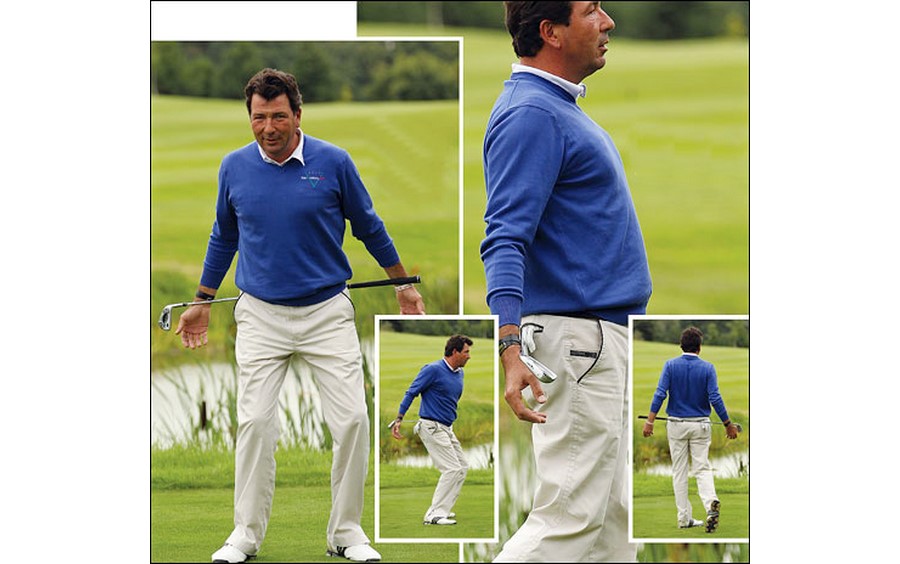
Keep your momentum going all the way way to a straight finish, chest facing left of your target
Rhythm is an essential element of swing. It’s up to you to identify with your own natural pace. The best solution is to swing the same way as you walk. Look at Fred Couples and Ernie Els: they walk and swing slowly, this does not prevent them from being as powerful as Padraig Harrington, for example, who is walking and swinging more quickly.
Identify your ideal, natural golf posture
There is no such thing as a ‘textbook’ posture – we are all of different height and build and so will each have our own ideal posture.
Here’s a a simple way to think about finding it – and the more you do this and improve the way you stand to the ball, the easier it will be to make a good, natural swing. Conjure in your mind images of Arthur, the skeleton used in medicine, and think of the way the arms hang vertically to the side when he is suspended – just as yours will if you stand straight and take a deep breath. (Your arms are the only part of the body that is suspended – the rest is stacked.) Now, bend from the pelvis and you will feel your arms hanging below your shoulders – suspended!
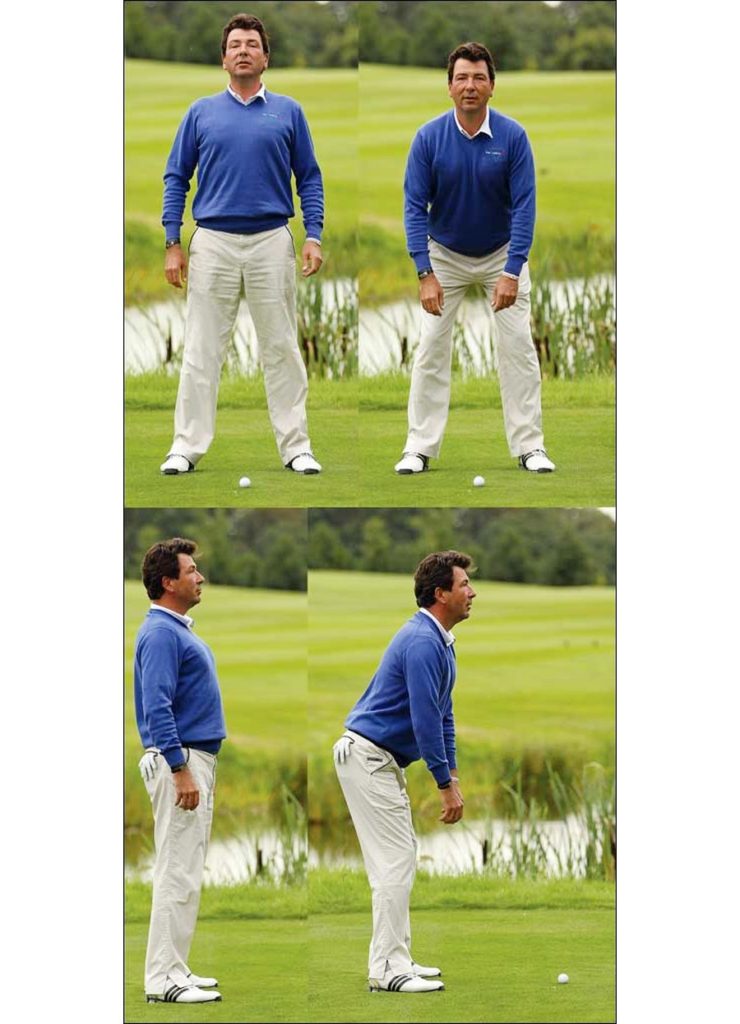
Exhale fully as you bend from the hips, add a little flex to the knees and allow the arms to hang.
Shoulders back, chest out and arms relaxed and suspended at your side.
Bend from the hips, stick your rear end out, and flex the knees to add balance
Now, to create a good spine angle, return to a tall standing position and hold a club down your back. You want to feel 2 points of contact: (1) where the club touches the back of your head, and (2) where the shaft touches your tail-bone. Ideally you want the lower part of your back to touch the shaft for about 10cm. That’s comfortably straight, not curved.
Keeping that club firmly in place, tilt your upper body forwards from the pelvis to experience the sensation of creating good spine angle at the set-up; can you still feel those 2 contact points?
Just as I am demonstrating on the opposite page, release your arms and let them be as free as they can be. They hang directly below the shoulders and are now ready to respond to the movement of your body during the swing. You will add a final sense of motion and natural athleticism if you then just flex the knees gently.
You are now in a position to make a flowing movement – one that is based on the feeling you take from the ground.
Bend from the hips for spine angle
Pulling a club against your spine like this heightens your awareness for the angle you create as you bend gently from the hips/pelvis. Try to keep the club in contact with your tail-bone and the top of your head as you ease your upper body forward and then flex your knees to add a sense of balance to your overall posture. Then release the arms and let them hang.
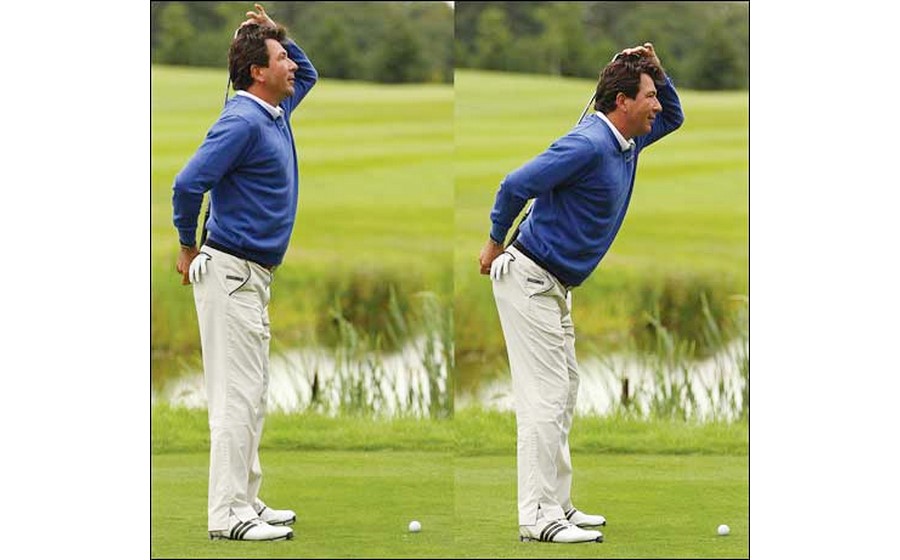
Now simply let the arms hang freely, and relax your head.

Feel the weight of the arm-club unit hanging down
Get rid of parasites! Look straight ahead, take your mind off the ball, and feel motion and balance in your toes


Experience the simplicity of a natural walking ‘swing’… …and not a technical thought in your head!
To summarise thus far: we are looking for a natural movement that shares the same rhythm as your regular walking pace; a movement that is inspired by the natural kinetic chain working from the feet-kneeships- chest-shoulders-arms, and we are doing this without a single technical thought in mind. I hope you can sense the flowing motion in this sequence, which you may have noticed I have made without looking at the ball. There’s a reason for that. When you walk you look into the distance – you don’t look down at all potential hazards that might trip you over. You instinctively know where to place your feet. Drawing on that notion, making a golf swing without looking at the ball is a wonderful exercise that enables you to focus on making a fluent swing without being fixated on the ball. Feel the inertia and the weight of the arm-club unit moving around you. Let your arms and the club respond to your natural body movement.

2. Keep the same pressure in both hands until the end
3. And there is the final swing position – ‘I am the ball’!
Do not try to hit the ball, simply let it get in the way of the clubhead – it has the force on its side.
No finish, no future! “I am the ball” – hold it for 7 seconds, the ‘drop down’ completes the swing
I tell all of my pupils to find their finish and hold it for 7 seconds. I don’t know where I came up with the number, it just seems right somehow. Doing this enables you to watch the ball until it stops completely (and avoid losing it!), and also to check your balance all the way to this ‘drop down’ of the arms.
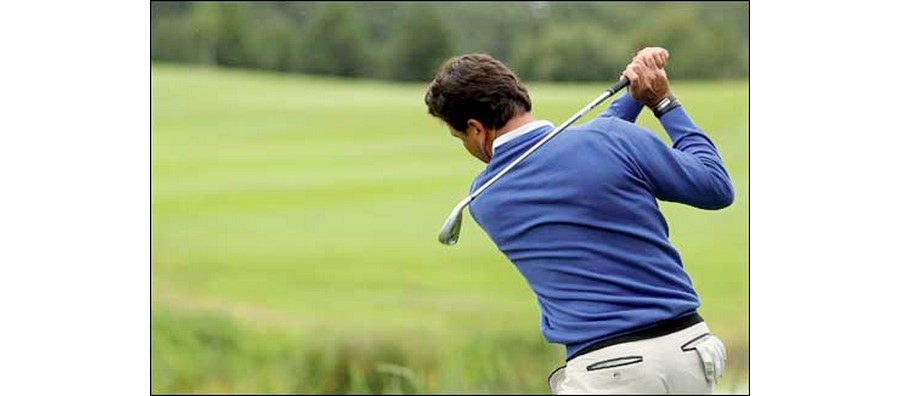
Do not try and control it – let the arms respond to the movement all the way from the toes up.
All coaches agree on this point: If you want to hit solid and consistent shots, you need to focus on making a full and balanced follow-through. The priority is to rotate your hips all the way through so that you are able to find your balance on the left leg (right for lefties) and ‘live’ the flight of your ball into your finish. Swing your hands all the way around behind your head and then let the arms fall down in time with the flight of the ball, the club coming to rest on your left shoulder.
The finish is more important than the swing.
Even if you hit a bad shot, finish your move. You will be well surprised at the results very quickly!
You will find that in doing this you forget all of those negative instructions that typically run through your mind – the parasites that are so good at ruining a natural swing!
